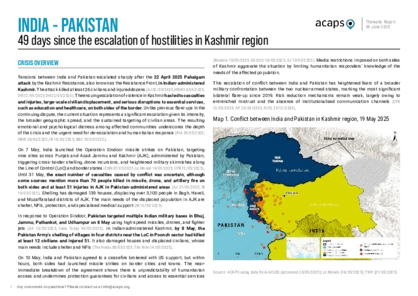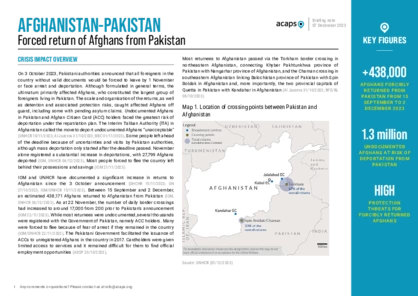Latest updates on country situation
30 September 2025
By 30 September 2025, monsoon floods in Pakistan had affected 6.9 million people, damaged 12,000 houses, and displaced around 3.5 million. The meteorological department has issued a dengue alert across the country, with several flood-hit areas reporting new cases, warning of an elevated outbreak risk between 20 September and 5 December, tied to post-monsoon conditions and standing water from floods. (OCHA 26/09/2025, PMD 15/09/2025, Dawn 30/09/2025)
16 September 2025
By 16 September 2025, floods in Pakistan had affected 6.3 million people and displaced 2.9 million. The worst-hit province is Khyber Pakhtunkhwa, while Southern Punjab and Sindh continue to face severe impacts, with 992 deaths, 1,062 injuries, and widespread infrastructure damage so far. Authorities warn of further rainfall and dengue risks in Sindh’s major cities. (ECHO 16/09/2025, OCHA 16/09/2025, Arab News 15/09/2025)
09 September 2025
By 9 September 2025, monsoon floods in Pakistan had affected 5.6 million people, creating a fast-escalating humanitarian crisis since rains began on 26 June. At least 910 people have died, including over 500 in Khyber Pakhtunkhwa and 234 in Punjab, while more than 2.1 million have been displaced. Nearly 6,000 homes have been damaged and 2,000 destroyed, leaving thousands without shelter. Punjab is the worst hit, with 4.1 million people across 4,100 villages severely affected. In Sindh, more than 100,000 people have been evacuated as authorities monitor rising Indus River inflows that threaten downstream communities. The floods have generated urgent needs in shelter, food, health, WASH, and psychosocial support. Rainfall between June–August already exceeded seasonal averages, overwhelming soil and drainage systems, while forecasts for 8–14 September indicate above-normal rains in parts of Balochistan, Gilgit-Baltistan, Punjab, and Sindh, likely worsening the crisis. (ECHO 09/09/2025, WFP 09/09/2025, AJ 08/09/2025)
19 August 2025
Between 14–16 August 2025, intense monsoon rains triggered flash floods, cloudbursts, and landslides, particularly in Khyber Pakhtunkhwa (KP) province and Gilgit-Baltistan (GB) region, killing more than 300 people, including over 180 in KP alone. Since 26 June, the impact of monsoon-triggered hazards has been severe across the country, with over 2,700 houses destroyed or damaged, 587 livestock lost, 124 bridges washed away, and nearly 450km of roads rendered impassable. By 19 August, nationwide casualties had risen to 695 deaths and 958 injuries. The worst-affected areas include Azad Jammu and Kashmir, GB, KP, and Punjab, where heavy monsoon rains have cut off many communities and hampered response operations. There is a heightened risk of disease outbreaks from contaminated water sources and disrupted WASH facilities, raising urgent health concerns. With the monsoon expected to remain active and a westerly wave approaching, the risk of further flooding and landslides remains elevated. (ECHO accessed 19/08/2025, IR 16/08/2025, AJ 15/08/2025)
22 July 2025
Between 26 June and 16 July 2025, floods across Pakistan killed at least 216 people, injured 562, and displaced 3,250, affecting around 5,000. The disaster has severely affected livelihoods, destroying crops and killing livestock. The monsoon season is expected to bring more heavy rain, increasing the risk of floods and landslides, particularly in the country’s northern and eastern regions. (IFRC accessed 22/07/2025, ECHO accessed 22/07/2025, AJ 22/07/2025)
01 July 2025
By 30 June 2025, heavy rainfall in Balochistan, Khyber Pakhtunkhwa, Punjab, and Sindh provinces had killed at least 45 people and injured another 68. At least 1,050 people had been displaced, while 89 homes were damaged or destroyed. The National Disaster Preparedness Authority has issued a countrywide flood alert, warning of more precipitation and potentially extreme weather conditions. (ECHO 30/06/2025, AJ 30/06/2025, The Nation 29/06/2025)
12 May 2025
On 10 May 2025, India and Pakistan reached a temporary ceasefire agreement, ending four days of fighting following the Indian-administered 22 April Pahalgam (Kashmir) attack. The clashes killed at least 46 civilians, injured over 90, and forced thousands to flee their homes. Despite the truce, residents remain anxious, fearing that violence could resume if the agreement fails. (Reuters 10/05/2025, AJ 12/05/2025, IR 09/05/2025)
current crises
in
Pakistan
These crises have been identified through the INFORM Severity Index, a tool for measuring and comparing the severity of humanitarian crises globally.
PAK009 - 2025 Monsoon Floods
Last updated 28/11/2025
Drivers
Floods
Crisis level
Country
Severity level
3.3 High
Access constraints
3.0
PAK006 - Floods and political and economic crisis
Last updated 28/11/2025
Drivers
Floods
Political/economic crisis
Crisis level
Country
Severity level
4.1 Very High
Access constraints
4.0
PAK007 - Displacement from Afghanistan to Pakistan
Last updated 28/11/2025
Drivers
International Displacement
Crisis level
Country
Severity level
3.6 High
Access constraints
4.0
PAK008 - Multiple crises
Last updated 28/11/2025
Drivers
Floods
International Displacement
Political/economic crisis
Conflict/ Violence
Crisis level
Country
Severity level
4 High
Access constraints
4.0
PAK004 - Conflict in Azad Jammu & Kashmir
Last updated 28/11/2025
Drivers
Conflict/ Violence
Crisis level
Country
Severity level
Access constraints
2.0
Analysis products
on
Pakistan
12 June 2025
Pakistan: key crises to watch
DOCUMENT / PDF / 574 KB
This report outlines the key humanitarian crises expected to affect Pakistan in the next six months of 2025. It is intended to support humanitarian planning and anticipatory action by providing an analytical overview of the the current situation, as well as potential risks having a humanitarian impact.
Attached resources
09 June 2025
India - Pakistan: 49 days since the escalation of hostilities in Kashmir region
DOCUMENT / PDF / 573 KB
This report provides an overview of how the crisis has evolved over the past 45 days since the Pahalgam attack in India-administered Kashmir on 22 April 2025. It is meant to highlight priority needs and humanitarian response constraints in both Indian-administered and Pakistan-administered Kashmir as a result of the escalating conflict between the two nations.
09 October 2024
Pakistan: 2024 monsoon floods
DOCUMENT / PDF / 330 KB
In 2024, Pakistan has experienced an exceptionally intense monsoon season (typically from July–September), leading to extensive damage and casualties. In some parts of the country, rainfall levels have reached up to 318% above normal.
30 November 2022
Pakistan: flooding
DOCUMENT / PDF / 2 MB
Since June 2022, heavy monsoon rainfall has led to an unprecedented crisis in Pakistan, causing floods, flash floods, and landslides. The disaster has significantly affected southern and central Pakistan, mostly affecting Balochistan, Khyber Pakhtunkhwa, and Sindh provinces .






